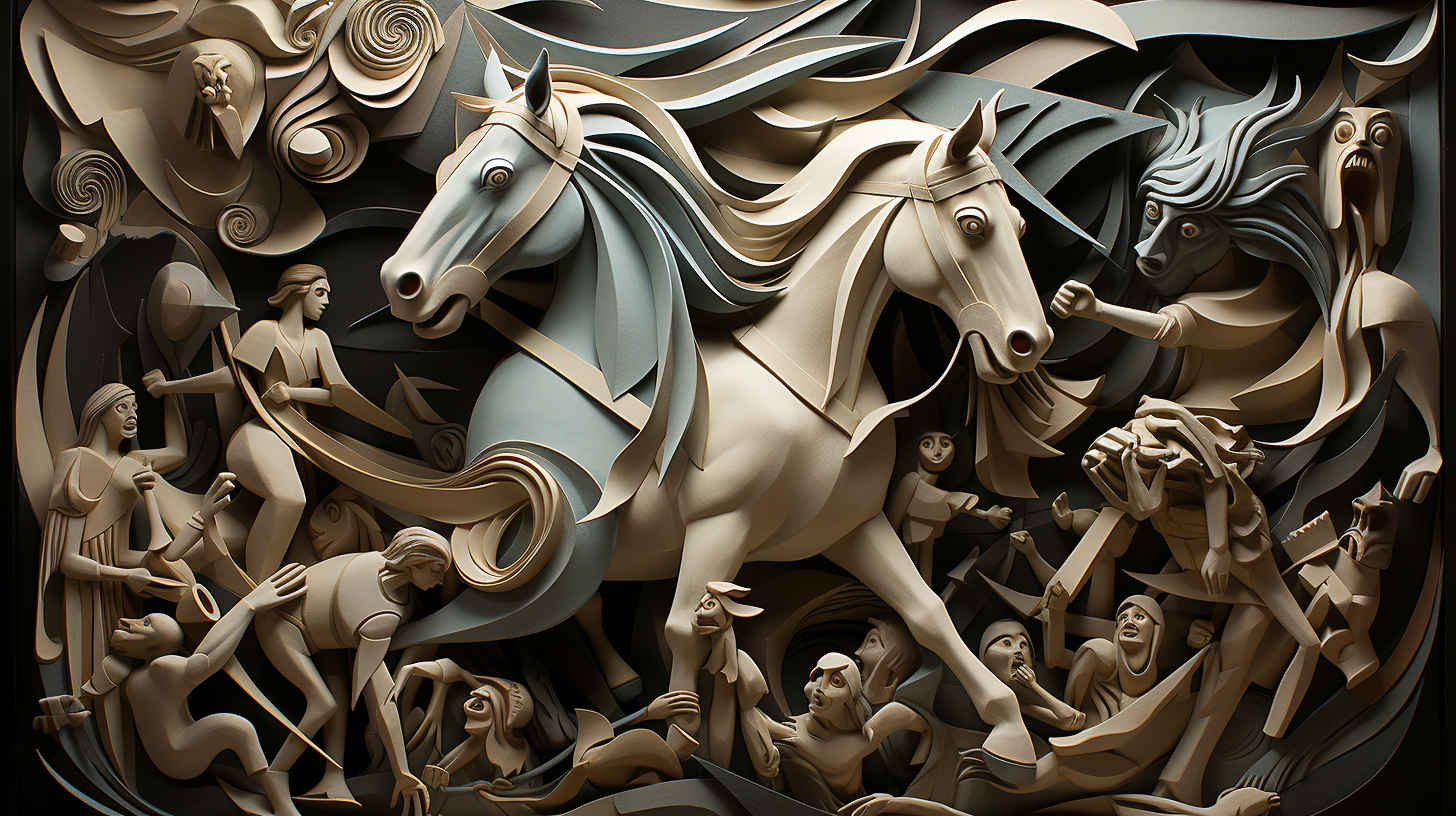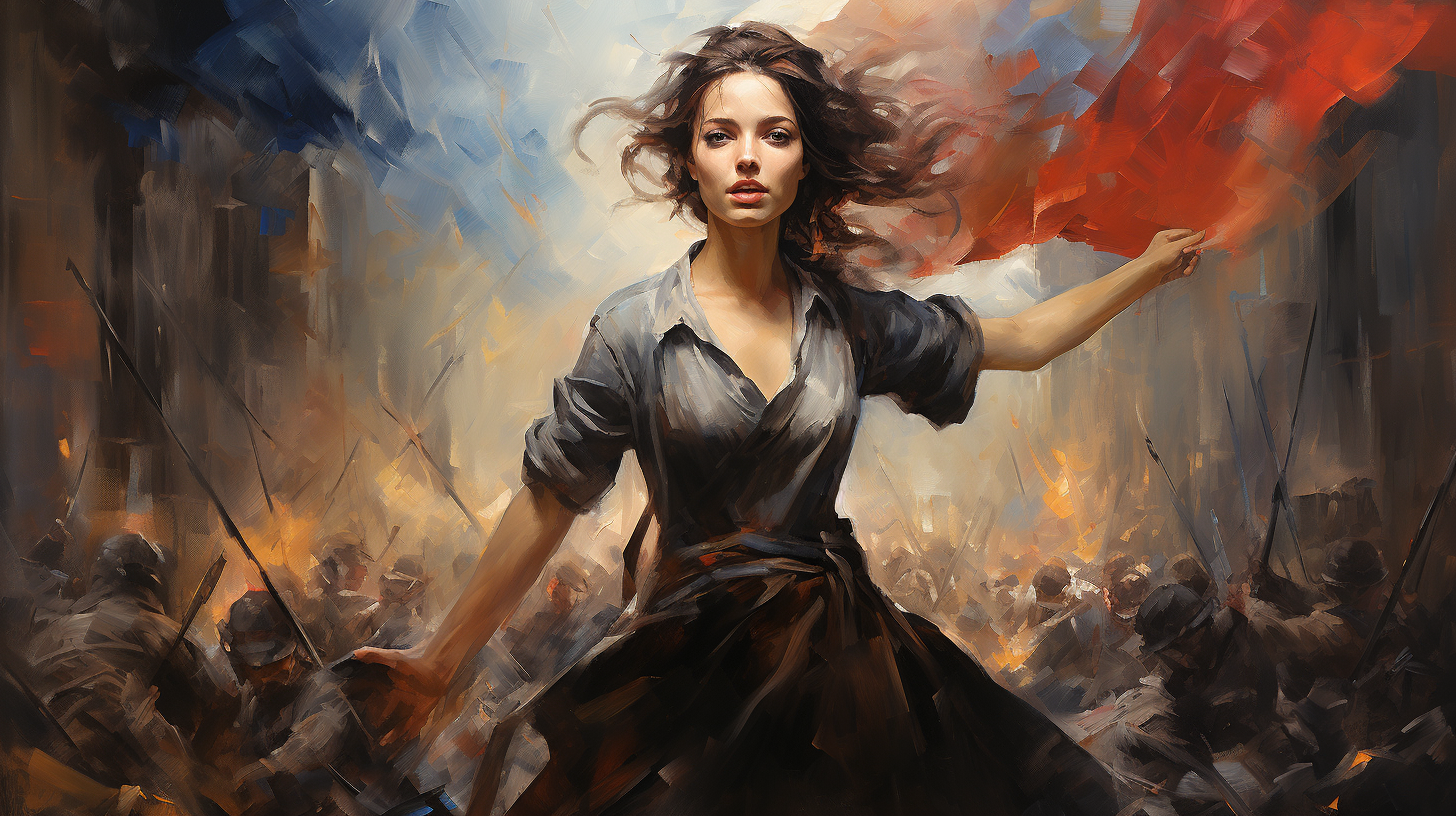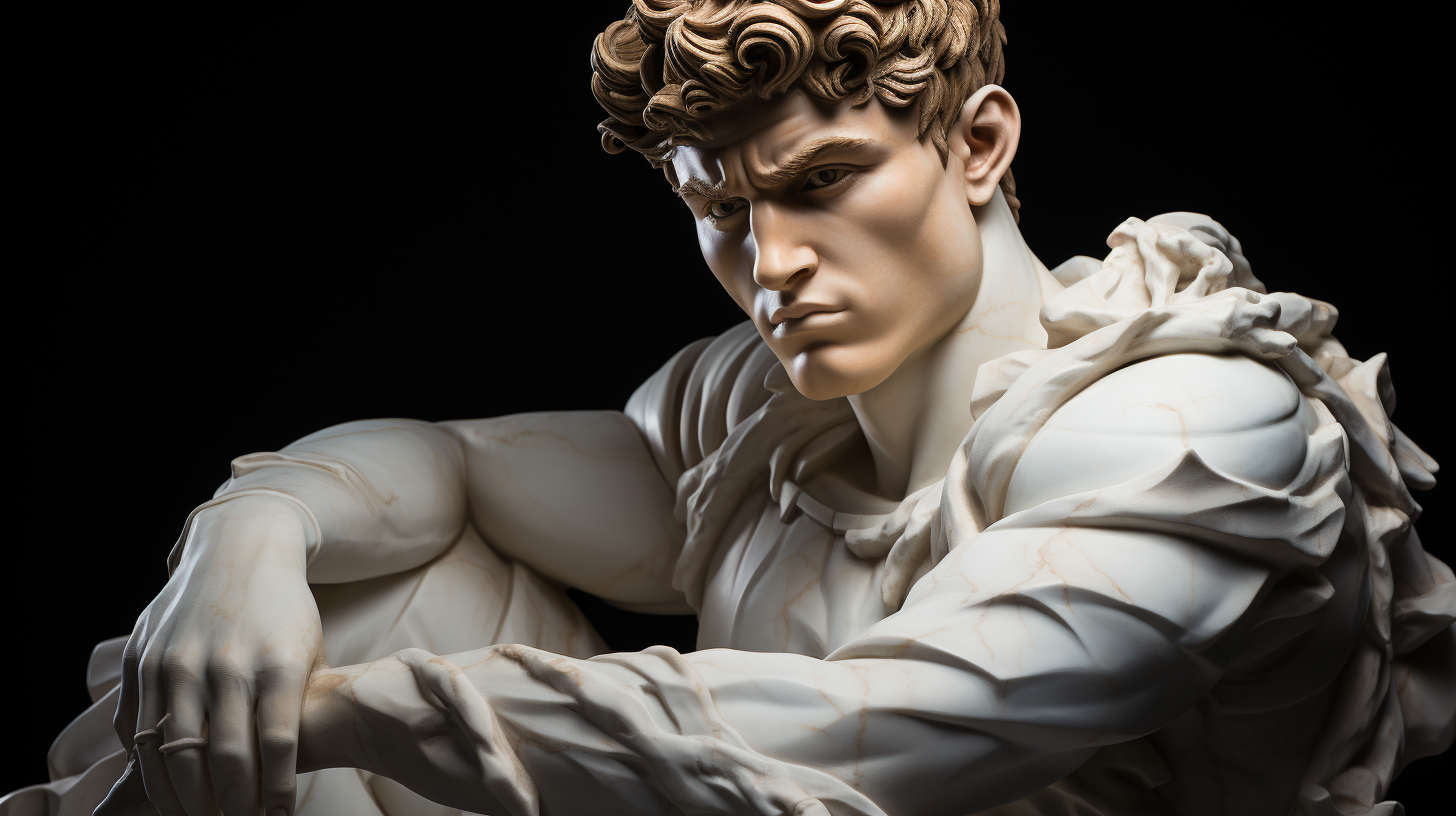Top 10 Artworks That Symbolize Overcoming Adversity: Inspiring Triumphs
Top 10 Artworks that symbolize overcoming adversity include Edvard Munch’s “The Scream” and Frida Kahlo’s “The Two Fridas.” These artworks capture the essence of resilience and human spirit.
Art has always been a powerful medium for expressing human emotions. Many artists have used their work to depict the struggle and triumph over adversity. These masterpieces not only tell personal stories of pain and recovery but also resonate with a universal audience.
They inspire viewers to find strength and hope in challenging times. From historical pieces to contemporary works, each artwork offers a unique perspective on overcoming obstacles. This blog explores ten such iconic artworks, highlighting their significance and the stories they tell.
Guernica By Pablo Picasso
Guernica is one of Pablo Picasso’s most famous paintings. It depicts the horrors of war and the strength of the human spirit. Created in 1937, it remains a powerful symbol of resilience. Here is the art you can get for you.

Historical Context
Guernica was painted during the Spanish Civil War. The work was a response to the bombing of the Basque town of Guernica. The attack was carried out by Nazi Germany and Italian Fascists. This tragic event killed and injured many innocent civilians.
Picasso painted Guernica to capture the pain and suffering. He wanted to show the world the atrocities of war. The painting was first displayed in the Spanish Pavilion at the 1937 Paris International Exposition.
Message Of Resilience
Guernica is not only about tragedy. It also represents resilience and hope. The painting shows people and animals in agony, but it also includes symbols of strength.
- The bull stands strong, representing the spirit of Spain.
- A mother holds her dead child, symbolizing loss but also love.
- The flower growing from a broken sword shows hope amidst destruction.
These elements remind us that even in dark times, there is hope. The people of Guernica rebuilt their lives. Picasso’s painting remains a beacon of strength and courage.
The Persistence Of Memory By Salvador Dalí
The Persistence of Memory by Salvador Dalí is a renowned surrealist painting. Created in 1931, it features melting clocks in a dreamlike landscape. This artwork symbolizes the fluidity and unreliability of time. Many view it as a representation of overcoming mental and emotional obstacles.
Surrealism And Struggle
Dalí’s painting belongs to the surrealist movement, which focuses on the unconscious mind. Surrealism often explores themes of struggle, fear, and triumph. In this painting, the distorted clocks and barren landscape reflect inner turmoil.
The melting clocks can signify the stress and pressure of time. They appear to be losing form, much like how people can feel overwhelmed. This visual representation of struggle resonates with many viewers.
Interpretations Of Time
The Persistence of Memory offers various interpretations of time. Some see it as a critique of rigid schedules and deadlines. The melting clocks suggest that time is not as fixed as it seems.

Others believe the painting shows how time can heal. The soft, fluid clocks may represent the passage of time easing pain. This interpretation aligns with the idea of overcoming adversity through patience and resilience.
Here are some key elements of the painting:
| Element | Symbolism |
|---|---|
| Melting Clocks | Fluidity of Time |
| Barren Landscape | Emotional Struggle |
| Ants on Clock | Decay and Impermanence |
Through these elements, Dalí communicates complex ideas about time and hardship. The Persistence of Memory remains a powerful symbol of overcoming adversity.
The Starry Night By Vincent Van Gogh
Vincent van Gogh’s The Starry Night is one of the most famous paintings in the world. Created in 1889, it shows a night sky filled with swirling clouds, glowing stars, and a bright crescent moon. The painting is known for its emotional depth and vibrant colors.
Personal Turmoil
Van Gogh painted The Starry Night during a difficult time in his life. He was staying in a mental asylum in Saint-Rémy-de-Provence, France. His mental health was poor, and he felt isolated and lonely. Despite his struggles, he continued to create art.
The painting reflects his inner turmoil. The swirling sky and chaotic patterns show his intense emotions. The village below, calm and quiet, contrasts with the stormy sky, highlighting his inner conflict.
Hope In Darkness
Though van Gogh faced many challenges, The Starry Night also symbolizes hope. The bright stars and moonlight break through the dark sky. This shows that even in the darkest times, there is light and hope.

Many people see the painting as a symbol of overcoming adversity. Van Gogh’s ability to create beauty despite his struggles inspires many. His work reminds us that hope can shine through even the toughest moments.
The Raft Of The Medusa By Théodore Géricault
The Raft of the Medusa is a powerful painting by Théodore Géricault. It depicts a tragic real-life event. The painting shows the aftermath of the shipwreck of the French naval frigate, Méduse. The survivors are stranded on a makeshift raft, fighting for their lives.
Tragic Inspiration
The painting was inspired by a true story. In 1816, the Méduse ran aground off the coast of Senegal. The captain abandoned the ship, leaving many passengers behind. They built a raft from the wreckage. Only a few survived the ordeal.
Géricault was deeply moved by this tragedy. He spent months researching the event. He interviewed survivors and studied cadavers. He wanted his painting to be realistic and emotional.
Human Spirit
The Raft of the Medusa symbolizes the strength of the human spirit. The survivors faced starvation, thirst, and madness. Yet, they never gave up hope. Géricault’s painting captures this resilience.
The composition of the painting draws the viewer’s eye to the figures at the center. Their expressions show a mix of despair and hope. The sea is rough, but the light on the horizon suggests salvation.
The painting is a testament to human endurance. It reminds us that we can overcome even the darkest times.
| Fact | Detail |
|---|---|
| Year | 1818-1819 |
| Medium | Oil on canvas |
| Dimensions | 491 cm × 716 cm |
Frida Kahlo’s Self-portraits
Frida Kahlo’s self-portraits are powerful symbols of overcoming adversity. Her art reflects her personal pain and cultural heritage. Each painting tells a story of strength and resilience.

Personal Pain
Frida Kahlo endured immense physical pain throughout her life. A bus accident left her with severe injuries. She had over 30 surgeries. Her paintings reflect this suffering.
In her self-portraits, she often shows her physical struggles. You can see her wearing medical braces and corsets. Her pain becomes a central theme in her art.
Cultural Significance
Frida Kahlo’s work also highlights Mexican culture. She used vibrant colors and traditional clothing. Her art celebrates her heritage.
Kahlo’s self-portraits often include symbols of Mexican folklore. This adds a rich cultural layer to her work. She is a national icon in Mexico.
| Aspect | Details |
|---|---|
| Personal Pain | Injuries, surgeries, and physical struggles depicted in art. |
| Cultural Significance | Mexican heritage, traditional clothing, and folklore symbols. |
- Frida Kahlo’s self-portraits are deeply personal.
- Her art reflects her physical and emotional pain.
- She incorporates Mexican cultural elements into her work.
Liberty Leading The People By Eugène Delacroix
Liberty Leading the People by Eugène Delacroix is a powerful artwork. It captures the essence of the French Revolution. This painting symbolizes the fight for freedom and overcoming adversity.
Revolutionary Spirit
The painting showcases a woman leading a diverse group of revolutionaries. She holds the French flag high. Her raised flag symbolizes hope and unity. The painting represents the revolutionary spirit of the people. It shows their determination to fight for their rights. The people in the painting are from different backgrounds. This diversity highlights the collective effort to overcome oppression. The revolutionary spirit is evident in their fierce expressions.
Symbol Of Freedom
The central figure is a personification of liberty. She symbolizes freedom and democracy. The French flag in her hand is a symbol of national pride. Her bare chest represents the birth of a new nation. The painting is a visual representation of the struggle for freedom. It inspires viewers to fight against injustice. The symbolism in the painting is powerful and enduring. It continues to resonate with people today.

The Scream By Edvard Munch
Edvard Munch’s The Scream is an iconic artwork that symbolizes overcoming adversity. This painting captures a moment of deep emotional turmoil. It has become a universal symbol of anxiety and existential dread.
Anxiety And Survival
The Scream showcases an open-mouthed figure in a landscape of swirling colors. This figure seems to be in the midst of a silent scream. The background, with its turbulent sky, amplifies the sense of chaos and distress.
The painting reflects anxiety, a common feeling when facing adversity. The figure’s contorted face and wide eyes convey pure terror. Yet, this very expression of fear also indicates a deep will to survive.
Munch created this work after a series of personal crises. His art became a way to process his emotions. The intense colors and abstract lines depict an inner struggle and the effort to endure.
Coping Mechanisms
The Scream serves as a visual representation of coping mechanisms. The act of painting allowed Munch to express his inner turmoil. This expression is a powerful coping mechanism in itself.
Art can be a therapeutic outlet for many. Creating or viewing art helps in processing complex emotions. It offers a way to confront and overcome adversity.
Many people find solace in creative activities. Whether through painting, writing, or music, these activities provide an emotional release. They also help individuals connect with others who share similar experiences.
In summary, The Scream by Edvard Munch is more than just a painting. It’s a testament to the power of art in navigating life’s challenges.
Michelangelo’s David
Michelangelo’s David is one of the most iconic sculptures in history. Created between 1501 and 1504, it stands as a testament to human resilience. The statue represents the biblical hero David, who defeated Goliath against all odds. This masterpiece symbolizes the triumph of the underdog and the power of inner strength.
Biblical Hero
The statue of David is based on the biblical story of a young shepherd. David bravely fights the giant Goliath with just a sling and a stone. This story is a powerful metaphor for overcoming adversity. It shows that even the smallest and weakest can achieve great things.
Symbol Of Strength
Michelangelo’s David is not just a statue; it is a symbol of strength and resilience. The statue’s detailed anatomy showcases physical strength and human potential. David’s calm and determined expression reflects mental fortitude. It teaches us to face our challenges head-on and with confidence.

Here are some key elements that make Michelangelo’s David a symbol of overcoming adversity:
- Detailed Anatomy: Represents physical and mental strength.
- Calm Expression: Shows determination and focus.
- Contrapposto Pose: Symbolizes readiness and balance.
Michelangelo’s David continues to inspire people worldwide. It reminds us that we can overcome any challenge with courage and strength.
The Triumph Of Death By Pieter Bruegel The Elder
The Triumph of Death is a powerful painting by Pieter Bruegel the Elder. The artwork dates back to the 16th century. It depicts a chaotic scene of death and destruction. The painting serves as a stark reminder of human mortality.
Confronting Mortality
Pieter Bruegel’s painting forces viewers to confront mortality. The scene includes skeletons, fires, and fallen structures. These elements represent the inevitability of death. The artist uses dark colors to highlight the grim reality. The artwork shows that death spares no one, regardless of status.
Resilience Through Art
Despite its grim theme, the painting also signifies resilience. People in the painting continue to fight against the skeletons. This symbolizes the human spirit’s desire to survive. Even in the face of death, there is a struggle to live. Bruegel’s work shows that art can capture this resilience.
| Element | Symbolism |
|---|---|
| Skeletons | Death and Mortality |
| Fires | Destruction |
| Fallen Structures | End of Civilizations |
The Triumph of Death remains a poignant reminder of life’s fragility. It teaches us about resilience and the human spirit.
The Night Watch By Rembrandt
Rembrandt’s The Night Watch is one of the most famous paintings in the world. It symbolizes leadership, community, and courage. This masterpiece tells a story of overcoming adversity.
Leadership In Adversity
The painting shows a group of soldiers led by Captain Frans Banning Cocq. He stands at the forefront, guiding his men with determination. His posture and expression show strength and resilience. The captain’s leadership is crucial during difficult times. His presence encourages the soldiers to stay united and brave.
Community And Courage
The soldiers in the painting represent a tight-knit community. They work together to face challenges. Each soldier has a role, and they trust one another. Their unity is a symbol of collective strength. This sense of community helps them overcome any obstacle.
Their courage is evident in their faces and body language. They are ready to face any danger. This bravery inspires viewers to stay strong in tough times. The painting reminds us that together, we can overcome adversity.
Frequently Asked Questions
What Is The #1 Most Famous Painting In The World?
The #1 most famous painting in the world is the Mona Lisa. Leonardo da Vinci created this masterpiece. The painting is housed in the Louvre Museum, Paris. Its enigmatic smile captivates millions of visitors annually.
What Famous Art Represents Hope?
Vincent van Gogh’s “Starry Night” represents hope through its swirling skies and vibrant colors. The painting evokes a sense of wonder and optimism.
What Famous Art Depicts Depression?
“The Scream” by Edvard Munch famously depicts depression. The painting captures intense emotional anguish.
What Famous Artwork Expresses Loneliness?
Edward Hopper’s “Nighthawks” expresses loneliness. The painting features isolated figures in a quiet, late-night diner.
Conclusion
These artworks inspire us to face challenges with courage and resilience. They remind us of human strength and perseverance. Each piece tells a unique story of triumph over adversity. Embracing these symbols can motivate us to overcome our own struggles.
Art truly has the power to heal and uplift.




